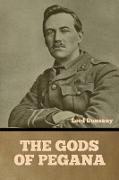- Start
- The Gods of Pegana
The Gods of Pegana
Angebote / Angebote:
The Gods of Peg¿na is the first book by Anglo-Irish fantasy writer Lord Dunsany, published on a commission basis in 1905. The book was reviewed favourably but as an unusual piece. One of the more influential reviews was by Edward Thomas in the London Daily Chronicle.
The book is a series of short stories linked by Dunsany's invented pantheon of deities who dwell in Peg¿na. It was followed by a further collection, Time and the Gods, and by some stories in The Sword of Welleran and Other Stories and possibly in Tales of Three Hemispheres.
The book contains a range of illustrations by Sidney Sime, the originals of all of which can be seen at Dunsany Castle.
In 1919 Dunsany told an American interviewer, "In The Gods of Peg¿na I tried to account for the ocean and the moon. I don't know whether anyone else has ever tried that before."
Aside from its various stand-alone editions, the complete text of the collection is included in the Ballantine Adult Fantasy collection Beyond the Fields We Know (1972), in The Complete Peg¿na (1998), and in the Gollancz Fantasy Masterworks omnibus Time and the Gods (2000). (wikipedia.org)
Bio
Edward John Moreton Drax Plunkett, 18th Baron of Dunsany (24 July 1878 - 25 October 1957, usually Lord Dunsany) was an Anglo-Irish writer and dramatist. Over 90 volumes of fiction, essays, poems and plays appeared in his lifetime. He gained a name in the 1910s as a great writer in the English-speaking world. Best known today are the 1924 fantasy novel, The King of Elfland's Daughter, and his first book, The Gods of Peg¿na, which depicts a fictional pantheon. Many critics feel his early work laid the grounds for the fantasy genre. Born in London as heir to an old Irish peerage, he was raised partly in Kent, but later lived mainly at Ireland's possibly longest-inhabited home, Dunsany Castle near Tara. He worked with W. B. Yeats and Lady Gregory supporting the Abbey Theatre and some fellow writers. He was a chess and pistol champion of Ireland, and travelled and hunted. He devised an asymmetrical game called Dunsany's chess. In later life, he gained an honorary doctorate from Trinity College Dublin. He retired to Shoreham, Kent in 1947. In 1957 he took ill when visiting Ireland and died in Dublin of appendicitis.
Dunsany was a prolific writer of short stories, novels, plays, poetry, essays and autobiography. He published over 90 books in his lifetime, not including individual plays. Books have continued to appear, with more than 120 having been issued by 2017. Dunsany's works have been published in many languages.
The then Edward Plunkett began his literary career in the late 1890s with published verses such as "Rhymes from a Suburb" and "The Spirit of the Bog", but he made a lasting impression in 1905. Writing as Lord Dunsany he produced the well-received collection The Gods of Peg¿na.
Dunsany's most notable fantasy short stories appeared in collections from 1905 to 1919, before fantasy had been recognised as a distinct genre. He paid for the publication of the first collection, The Gods of Peg¿na, earning a commission on sales. This he never again had to do.
The stories in his first two books, and perhaps the beginning of his third, were set in an invented world, Peg¿na, with its own gods, history and geography. Starting with this, Dunsany's name is linked to that of Sidney Sime, his chosen artist, who illustrated much of his work, notably up to 1922. ...(wikipedia.org)
Folgt in ca. 10 Arbeitstagen
